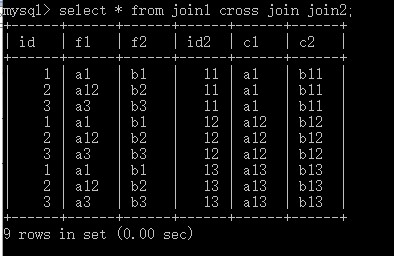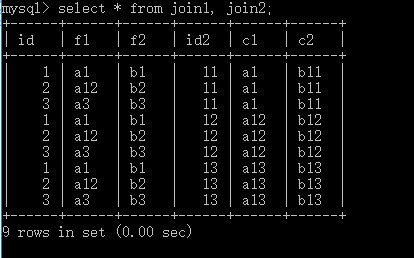語法形式:
```
from 表1 [cross] join 表2
```
說明:
1,交叉連接其實可以認為是連接查詢的“完全版本”,即所有行都無條件地都連接起來了。
2,關鍵字“cross”可以省略;
3,交叉連接又稱為“笛卡爾積”,通常應用價值不大。
4,交叉連接還有一種寫法: from 表1, 表2;
演示:


- 1、數據庫介紹
- 1.1.主流數據庫
- 1.2.MySQL數據庫概覽
- 1.3.關系數據庫
- 2、訪問mysql數據庫服務器
- 2.1.開啟/關閉數據庫服務
- 2.2.客戶端連接數據庫服務器
- 3、數據庫操作
- 3.1.查看所有數據庫
- 3.2.創建新數據庫
- 3.3.查看數據庫創建信息
- 3.4.刪除現有數據庫
- 3.5.修改現有數據庫
- 3.6.選擇(使用)某個數據庫
- 4、數據表操作
- 4.1.創建數據表初步
- 4.2.查看所有數據表
- 4.3.查看數據表結構
- 4.4.查看數據表的創建語句
- 4.5.刪除數據表
- 4.6.修改數據表
- 5、數據操作初步
- 5.1.插入數據
- 5.2.查詢數據
- 5.3.刪除數據
- 5.4.修改數據
- 6、MySQL數據類型
- 6.1.數據類型(列類型)總覽
- 6.2.整型
- 6.3.小數型
- 6.4.日期時間型
- 6.5.字符串型
- 7、列屬性
- 8、實體與實體的關系
- 8.1.基本概念
- 8.2.一對一關系
- 8.3.一對多關系
- 8.4.多對多關系
- 9、高級查詢
- 9.1.高級查詢語法概述
- 9.2.查詢結果數據及select選項
- 9.3.where子句
- 9.4.mysql運算符
- 9.5.group by子句
- 9.6.having子句
- 9.7.order by子句
- 9.8.limit 子句
- 10、高級插入
- 10.1.同時插入多行記錄
- 10.2.插入查詢的結果數據
- 10.3.set語法插入數據
- 10.4.蠕蟲復制
- 10.5.插入時主鍵沖突的解決辦法
- 11、高級刪除
- 11.1.按指定順序刪除指定數量的數據
- 11.2.truncate清空
- 12、高級更新
- 13、聯合(union)查詢
- 13.1.聯合查詢概念
- 13.2.聯合查詢語法
- 14、連接(join)查詢
- 14.1.連接查詢概述
- 14.2.交叉連接(cross join)
- 14.3.內連接(inner join)
- 14.4.外連接
- 14.5.自連接
- 15、子查詢(subquery)
- 15.1.子查詢的概念
- 15.2.標量子查詢
- 15.3.列子查詢
- 15.4.行子查詢
- 15.5.表子查詢
- 15.6.有關子查詢的特定關鍵字
- 15.7.exists子查詢
- 16、數據管理
- 16.1.數據備份
- 16.2.數據還原(數據恢復)
- 17、用戶管理:
- 17.1.查看用戶
- 17.2.創建用戶
- 17.3.刪除用戶
- 17.4.修改/設置用戶密碼
- 17.5.授予用戶權限
- 17.6.取消用戶授權
